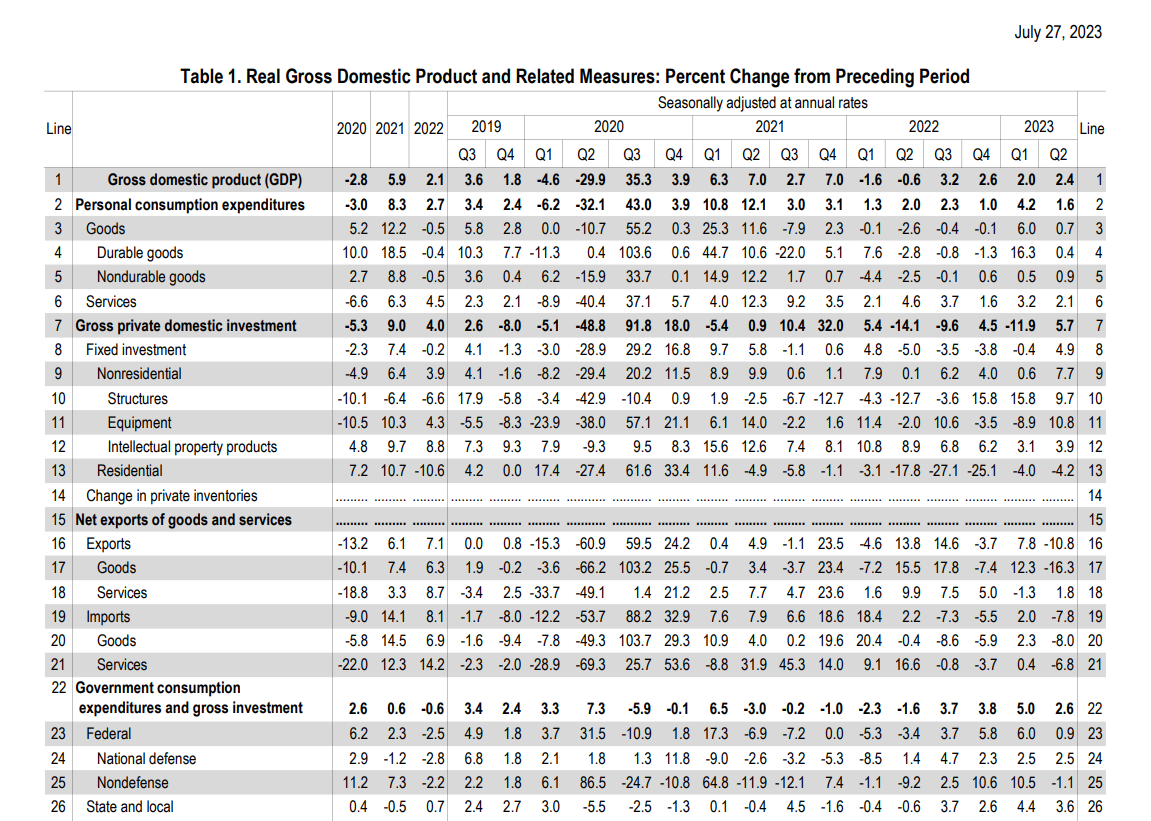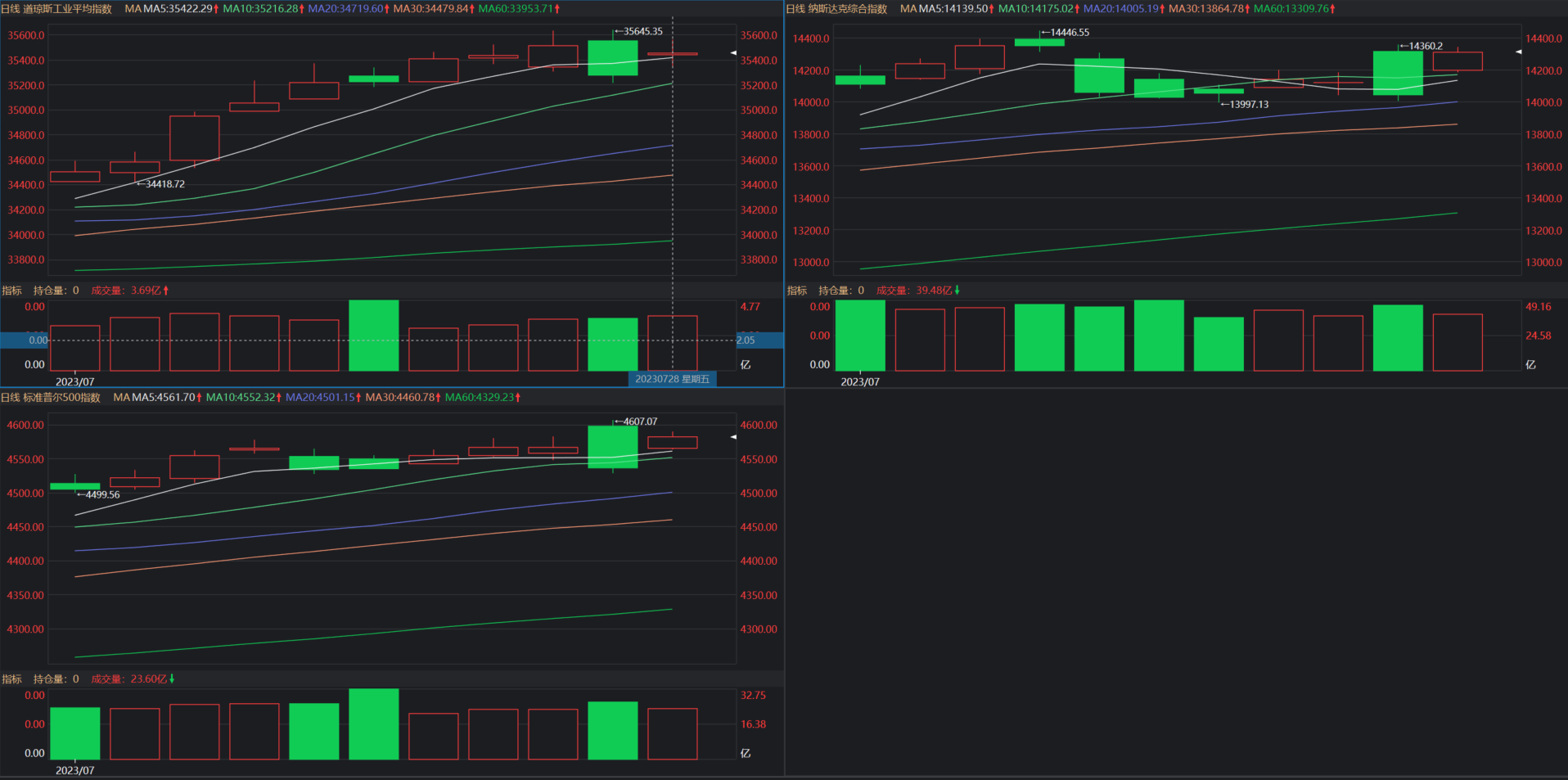2023Q2 U.S. GDP data interpretation: the probability of a soft landing is gradually rising
Investment was the biggest bright spot in U.S. GDP growth in the second quarter, with the data sub-item up 5.7%, contribution to GDP of 0.97 percentage points。
On July 27, local time (last Thursday), the U.S. Department of Commerce released the first estimate of U.S. real gross domestic product (GDP) for the second quarter of 2023.。Data show that the U.S. economy is still resilient: GDP recorded a 2.4%, higher than the previous value of 2%, and better than the expected 1.8%, mainly driven by imports, consumption and investment。

As the information is updated, the U.S. Department of Commerce will continue to re-estimate current GDP data。According to the schedule, the department will release the second estimate of GDP for the second quarter of this year on August 30, local time.。The Commerce Department said the acceleration in GDP growth in the second quarter compared to the first quarter of this year mainly reflected a pickup in private sector inventory investment and an increase in non-residential fixed investment, partially offset by weaker consumer spending, lower exports and lower government spending.。
The release of better-than-expected data, superimposed on the expected fermentation of the central bank's monetary policy adjustment, the day of the data release, U.S. debt, U.S. index strength, the three major stock indexes weakened: 10-year U.S. bond yields rose 13bp to 3.99%, the dollar index strengthened to 101.77; S & P 500 down 0.64%, Nasdaq down 0.55%, Dow Jones industrials down 0.67%。


Consumption momentum is still bright in non-residential investment growth.
Specifically, on the consumption side, personal consumption expenditure increased by 1% in the second quarter..6%, exceeding market expectations of 1.2%, contribution to GDP of 1.12 percentage points。Among them, commodity consumption was weaker, up 0% from the previous year..7%, service consumption increased by 2.1%, driving GDP upward beyond expectations。

The reason is that a healthy balance sheet for U.S. residents is an effective guarantee of consumer spending.。Public data show that as of the first quarter of 2023, the net assets of U.S. residents as a proportion of disposable income is still about 760%, although significantly lower than the previous high, but still about 58 percentage points higher than before the epidemic, on behalf of the U.S. residents balance sheet is more healthy, the consumer behavior constitutes a potential support.。
The current tight labor market in the United States also has strong support for nominal wages and consumer confidence.。Currently, the vacancy rate in the United States is stuck at 5.9%, the unemployment rate is still at 3.Historic low of 6%。In addition, the continued decline in U.S. inflation has effectively pushed disposable income back up quickly, boosting consumption.。According to data released on July 29, local time, the U.S. core PCE price index rose 4.10%, the smallest increase since September 2021。
Investment was the biggest bright spot in U.S. GDP growth in the second quarter, with the data sub-item up 5.7%, contribution to GDP of 0.97 percentage points。Although residential investment fell for the ninth consecutive month, down 4.2%, dragging GDP to 0.16 percentage points, but its non-residential investment grew at a 7.7%, the highest level since the first quarter of 2022。

It is understood that the increase in non-residential investment is mainly due to the rise in construction investment related to high-tech manufacturing under the support of the chip bill.。According to White House data, with the support of the Biden administration, private companies have so far announced $231 billion in semiconductor and power investments, $133 billion in trams and batteries, $103 billion in clean energy investments, and $19 billion in biomanufacturing investments, which, while not corresponding to the quarterly level, will undeniably slow the pro-cyclical downside of private investment at high interest rates to some extent.。
In terms of net exports, U.S. import and export data fell sharply in the second quarter.。In terms of exports, U.S. exports fell 10 percent in the second quarter from a year earlier..8%, the previous value is an increase of 7.8 percentage points; in terms of imports, U.S. imports fell 7 percent in the second quarter from a year earlier..8%, the previous value is an increase of 2 percentage points, net exports as a whole drag on GDP growth of 0.1 percentage point

In terms of government spending, the growth rate of this data segment declined from 5 per cent to 2 per cent..6%, driving GDP growth of about 0.45 percentage points。Among them, the growth rate of government consumption expenditure declined, from 4.9% down to 1.2%; investment expenditure growth rose, from 5.2% to 8.5%。By level, federal government spending grew by 0.9%, state and local government spending growth 3.6%。Increased state and local government spending, primarily reflecting higher compensation for state and local government employees and increased construction investment。

Institutional view: U.S. economic resilience exceeds expectations, soft landing probability rises
Looking ahead, several agencies say the possibility of a "soft landing" for the U.S. economy is gradually increasing.。
Everbright Macro said, outlook, consumption resilience, investment recovery is the core clue to determine the second half of the U.S. economy "soft landing."。The agency said the combination of recently released U.S. non-farm payrolls data, retail sales data, and this outsized economic data indicates that the U.S. economy remains resilient。Taking into account the second half of the U.S. consumption slow decline, the rate of decline is limited, the investment side to benefit from the peak of the interest rate hike cycle, real estate signs of recovery, as well as the Biden administration through various bills to pull the manufacturing industry back and other factors of support, the economy tends to "soft landing," the risk of recession further reduced。
Guangfa Macro said that looking back at the U.S. economy in the second quarter, resilience comes from three clues: first, low unemployment for income and consumption support;。Going forward, the loosening of the job market will lead to a slowdown in income and consumption momentum, the impact of supply chain replenishment pulse may gradually weaken, the economy continues to have slowing momentum, but the probability of a soft landing is rising。
Cathay Macro also believes that in the benchmark scenario we maintain the view that the U.S. economy will fall into a moderate recession, but the view of the U.S. economy in the second half of the year is marginally more optimistic, postponing the start of a moderate recession to the end of 2023 to the first quarter of 2024, while the probability of a soft landing (no recession) is increasing.。According to the agency, the shift in marginal optimism in U.S. economic expectations stems from two main factors: first, an unanticipated fall in inflation;。
Caitong Securities, on the other hand, said that overall, the U.S. economy is more resilient than expected, given that the pace of consumption decline or will slow down, while investment benefits from the real estate and inventory cycle in the future also shows signs of recovery, the possibility of a recession during the year is unlikely, we believe that the U.S. economy is likely to achieve a soft landing。On the one hand, if the U.S. economy achieves a soft landing, consumption resilience and the dawn of the inventory cycle may boost imports, thereby supporting China's export growth rate.。On the other hand, the stronger the U.S. economy performs, the less likely it is that the Fed will cut interest rates in the absence of systemic risk, and the longer the restrictive rate is likely to last。
·Original
Disclaimer: The views in this article are from the original Creator and do not represent the views or position of Hawk Insight. The content of the article is for reference, communication and learning only, and does not constitute investment advice. If it involves copyright issues, please contact us for deletion.